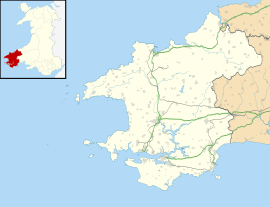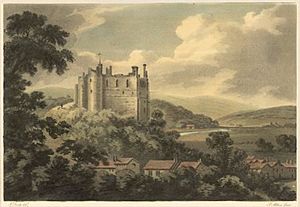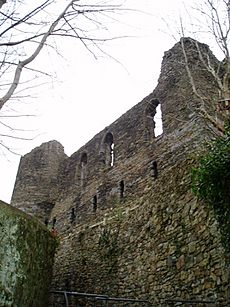Haverfordwest Castle facts for kids
Quick facts for kids Haverfordwest Castle |
|
|---|---|
| Part of Pembrokeshire | |
| Haverfordwest, Wales UK grid reference |
|
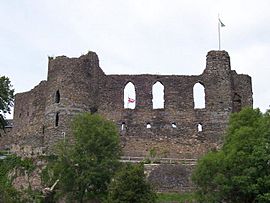 |
|
| Coordinates | 51°48′11″N 4°58′12″W / 51.803°N 4.97°W |
| Type | Castle |
| Site information | |
| Controlled by | Pembrokeshire Coast National Park Authority |
| Open to the public |
Yes |
| Condition | Partially restored |
| Site history | |
| Built | 1120 1290 Early 1380s |
| Built by | Gilbert de Clare, earl of Pembroke Queen Eleanor of Castile |
| In use | Until mid 18th century |
| Materials | Mortar Timber |
Haverfordwest Castle (Welsh: Castell Hwlffordd) is a castle right in the middle of Haverfordwest, Pembrokeshire, south Wales. It's built on a strong, isolated hill, which made it easy to defend. The castle was first started in 1120 by the Normans. However, most of the castle you see today was built much later, around 1290. For many years, this castle was an important English stronghold.
There are other cool castles nearby too. Wiston Castle is about 6 miles (10 km) to the northeast. Pembroke Castle is about 12 miles (19 km) to the south.
Contents
History of the Castle
Records from Pembrokeshire suggest there might have been an old Iron Age fort on the castle's site. But there's no physical proof of this today. People believe Haverfordwest was a Danish village before the Normans took over West Wales in 1093 or 1094.
In 1108, people from Flanders (called Flemish) moved to the area. They helped protect the main Norman castle at Pembroke Castle from Welsh raiders coming from the north.
Early Norman Times
Most sources say the castle was first a stone tower (keep) and a walled courtyard (bailey). It was built by Gilbert de Clare, a powerful lord of Pembroke, in 1120. Some dates suggest it was built a bit earlier, in 1110 or 1113.
However, Pembrokeshire records say the castle was actually built by Tancred the Fleming. He was married to Gwladus, who was the aunt of Gerald of Wales. This would mean the original town and castle were Flemish, not Norman. Either way, Gilbert de Clare put Tancred's son, Richard fitz-Tancred, in charge of the castle.
The first attack on the castle happened around 1135 or 1136. Gruffydd ap Rhys, a Welsh prince, tried to capture it but failed. In 1173, King Henry II visited the castle. He was on his way back from a trip to Ireland.
In 1188, Gerald of Wales visited the castle with Archbishop Baldwin. They were traveling around Wales to encourage people to join the Third Crusade. This crusade was led by King Richard I, also known as Richard the Lionheart.
Building with Stone
By 1200, many of the castle's original wooden buildings were replaced with stone. This included a rectangular tower in the northeast, which was the castle's main strong point. Around the same time, Robert fitz-Richard, son of Richard fitz-Tancred, started a religious house called Haverfordwest Priory. He retired there in 1210.
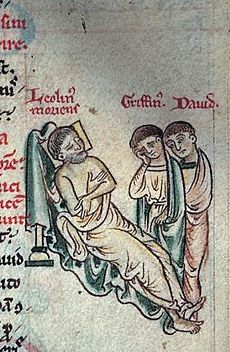
That same year, King John passed through Haverford. He was sailing to Ireland to stop a rebellion by the Normans there. In 1213, the King asked William Marshal, a very rich and powerful Earl, to put soldiers in the castle. William Marshal had taken over the surrounding area.
William Marshal was responsible for replacing most of the castle's original wooden walls, towers, and gatehouse with stone. This happened in the 1210s. By 1220, very little of the first castle remained. Today, the only part left from the 1120 castle is a large square tower in the northeast corner of the inner area. This big rebuilding project made the castle much stronger, likely because of the many attacks during this time.
Attacks and Royal Visits
In 1217, Llywelyn Fawr (Llywelyn the Great), the Prince of Wales, threatened William Marshal. In 1220, Llywelyn burned the town of Haverfordwest but couldn't capture the castle. After the town was burned, it was rebuilt even bigger and grew quickly in the 13th century. It became an important trading center because of its location and its links to the sea.
In 1248, Humphrey II de Bohun took over the castle. He successfully defended it in 1257 against an attack by Llywelyn ap Gruffudd, Prince of Gwynedd (Llywelyn the Last). In 1265, William de Valence, Earl of Pembroke, captured Haverfordwest Castle during a war. But in 1274, the King stepped in and gave it back to the de Bohun family, to the next generation, Humphrey III de Bohun.
In 1284, King Edward I and Queen Eleanor of Castile visited the castle for the first time. They were on a royal trip to St Davids. People said Queen Eleanor loved the castle. Four years later, she borrowed a huge amount of money to buy the castle from the de Bohun family. She spent £407 (a massive sum back then) to completely rebuild the castle in stone.
This huge rebuilding project finished a year later in 1290, shortly before she died. The castle became known as the "Queen's Castle at Haverford." Today, much of what you see is from Queen Eleanor's 1290 version, including the long outer wall. The castle stayed in royal hands after Eleanor's death and was given to different rich tenants.
Later Years and Civil War
In the 14th century, many different owners lived in the castle. One of them was Edward, the Black Prince, from 1359 to 1367. The crown owned the castle from 1381 to 1385 and paid for repairs. These repairs were important later. In 1405, the castle was strong enough to defend itself during Owain Glyndŵr's Welsh fight for independence.
The town walls around the high ground near the castle also helped protect it from attackers. However, none of these town walls remain today. Over the years, many important people visited the castle, including King Richard II and Oliver Cromwell.
By the 16th century, the castle was falling apart. But it was made strong again during the English Civil War. In 1644, Haverfordwest Castle was held by the Royalists. However, they left it because they thought the sound of cows was a Parliamentary army.
The castle was later taken back and held for the King for a year. It finally gave up after the Battle of Colby Moor nearby. Oliver Cromwell sent letters to the castle in July 1648, ordering it to be destroyed. He threatened to put the townspeople in prison if they didn't tear it down. These letters were found in 1986 and are now in the town museum.
Castle as a Prison
The old medieval castle was turned into a prison in 1779. However, records from Giraldus Cambrensis show that part of the castle was used as a prison as early as 1188.
In 1820, a new prison building was built inside the castle grounds, mostly in the inner courtyard. It could hold 86 prisoners. In 1878, the remaining prisoners were moved to the jail in Carmarthen. The building has since been used as a police station and council offices.
Today, the building houses a museum. You can see a cell door, leg irons, the original lock from the castle gate, and many other old items. The Pembrokeshire Coast National Park Authority now manages the castle, and it is open for people to visit.
In 2010, there were plans to sell the prison building. New council offices were going to be built in another part of Haverfordwest. In January 2008, a big archaeological dig took place at Haverfordwest Castle.
Castle Architecture
The original way into the castle was on the west side, protected by a gatehouse. But there's no sign of it left today. There are round towers on the northwest and southwest corners. In the southeast corner, there's a square tower with an extra small tower sticking out.
The southwest and southeast towers have three floors. The southeast tower also has a basement and a secret back gate. This gate could be used for a surprise attack during a siege. A large hall is located south of the castle, with big, high windows.
Not much is left of the original medieval defenses in the outer part of the castle. However, the long outer wall has been kept up and still stands. A large part of the north side also remains, including a half-circle tower and a square tower to the east.
Images for kids


